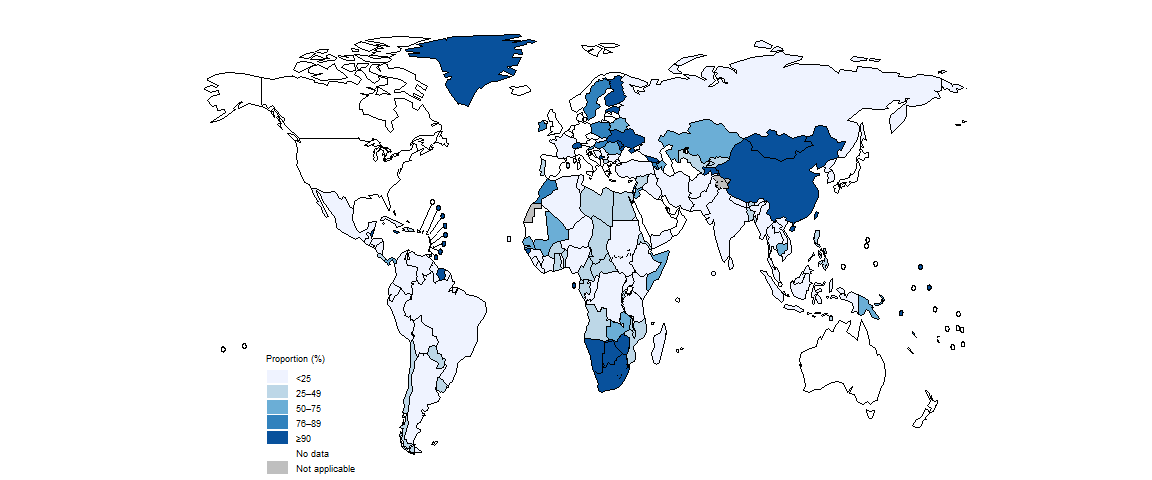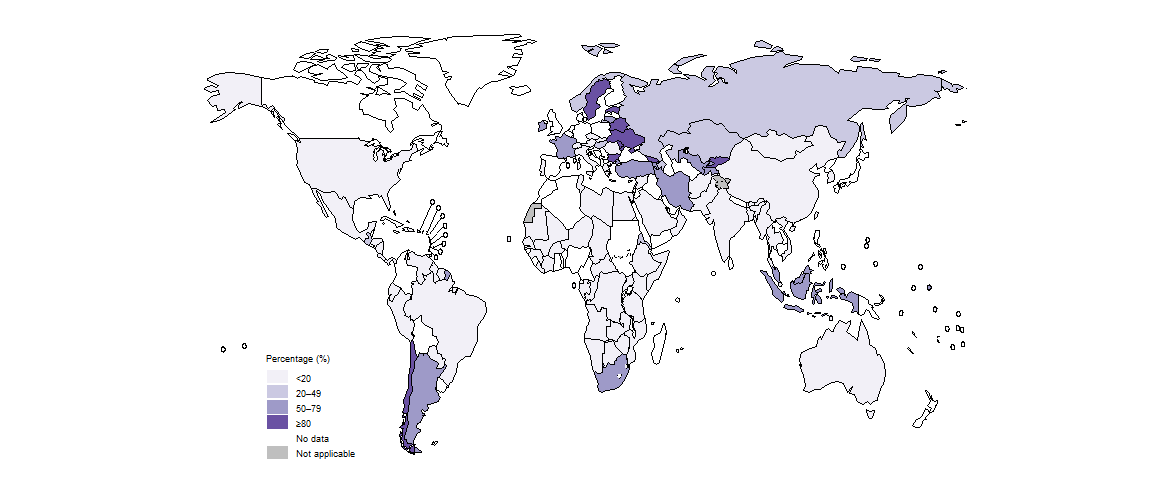
2.2 Diagnostic testing
An essential step in the pathway of tuberculosis (TB) care is rapid and accurate diagnostic testing. Since 2011, rapid molecular tests that are highly specific and sensitive have transformed the TB diagnostic landscape, which previously relied upon more traditional microscopy and culture methods.
People diagnosed with TB using rapid molecular tests recommended by WHO (1), lateral flow urine lipoarabinomannan (LF-LAM) assays, sputum smear microscopy or culture are defined as “bacteriologically confirmed” cases of TB (2). The microbiological detection of TB is critical because it allows people to be correctly diagnosed and started on the most effective treatment regimen as early as possible. People diagnosed with TB in the absence of bacteriological confirmation are classified as “clinically diagnosed” cases of TB.
Bacteriological confirmation of TB is necessary to test for resistance to anti-TB drugs. Such testing can be done using rapid molecular tests, phenotypic susceptibility testing or genetic sequencing.
A global total of 8.2 million people were newly diagnosed with TB and notified as a TB case in 2023; of these 6.9 million (84%) had pulmonary TB (Table 2.1.1 of Section 2.1). Worldwide, the percentage of people diagnosed with pulmonary TB based on bacteriological confirmation improved between 2018 and 2021, from 55% to 63%; it remained at 62%–63% in 2022–2023 (Fig. 2.2.1). Among the six WHO regions, there were steady improvements between 2020–2023 in the African Region (from 65% to 69%) and the Region of the Americas (from 77% to 81%); in other regions, levels of bacteriological confirmation were either stable or fell slightly. Efforts to reach the level already achieved in the Region of the Americas are required in other regions.
In 2023, there was considerable country variation in the proportion of people diagnosed with a new episode of pulmonary TB who were bacteriologically confirmed (Fig. 2.2.2).

In general in 2023, levels of bacteriological confirmation
were highest in high-income countries (median, 86%), where there is wide
access to the most sensitive diagnostic tests, and lowest in low-income
countries (median, 71%) (Fig.
2.2.3). Over-reliance on direct sputum smear microscopy is
inherently associated with a relatively high proportion of pulmonary TB
cases that are clinically diagnosed, as opposed to bacteriologically
confirmed.
In the 30 high TB burden countries (Fig. 2.2.4), variation in the proportion of people diagnosed with pulmonary TB who were bacteriologically confirmed likely reflects differences in diagnostic and reporting practices. The countries with relatively high levels of bacteriological confirmation in 2023 (75% or above) were Brazil, Liberia, Mongolia, Namibia, Nigeria and Viet Nam.
There is clear scope for improvement in most other high TB burden countries. This is particularly needed in Angola, the Democratic People’s Republic of Korea, Indonesia, Lesotho, Mozambique, Myanmar, Pakistan, Papua New Guinea, the Philippines and the United Republic of Tanzania, where levels of bacteriological confirmation remained around or below 50% in 2023. Such levels of bacteriological confirmation show overdependence on clinical diagnosis of TB and potentially over-diagnosis. When the proportion of people diagnosed with pulmonary TB based on bacteriological confirmation falls to around or below 50%, a review of the diagnostic tests in use and the validity of clinical diagnoses is warranted (e.g. via a clinical audit).
Among other 30 high TB burden countries, there has been a steady upward trend in recent years in China, the Congo and Thailand.
At the second United Nations (UN) high-level meeting on TB in September 2023, Member States adopted a new target that, by 2027, 100% of people diagnosed with TB should be initially tested with a WHO-recommended rapid diagnostic test (WRD) (3).
Globally in 2023, a WRD was used as the initial diagnostic test for 48% (3.9 million) of the 8.2 million people newly diagnosed with TB in 2023, a slight increase from 47% (out of a total of 7.5 million) in 2022 and up from 38% (out of a total of 6.4 million) in 2021 (Fig. 2.2.5). Among WHO regions, the best level of coverage was achieved in the European Region (78%); the lowest coverage was in the South-East Asia Region (39%).

Among the 30 high TB burden countries, those with high proportions (≥80%) of people diagnosed with TB who were initially tested with a WRD in 2023 included Gabon, Mongolia, Mozambique, Namibia, South Africa and Zambia (Fig. 2.2.7).
Among the 49 countries in one of the three global lists of high burden countries (for TB, HIV-associated TB and MDR/RR-TB) being used by WHO in the period 2021–2025 (Annex 3 of the core report document), 31 reported that a WRD had been used as the initial test for more than half of their notified TB cases in 2023, unchanged from 2022 but up from 27 in 2021.
In 2023, the proportion of TB diagnostic sites with access to WRDs varied considerably by country (Fig. 2.2.8). Only seven of the 30 high TB burden countries reported that more than 50% of their TB diagnostic sites had access to WRDs: China, Lesotho, Mongolia, Namibia, Papua New Guinea, South Africa and Zambia. Expanding access to TB diagnosis using rapid tests should be a top priority for all countries. Globally, the median was 35% (interquartile range [IQR]: 13–82%), up from 33% in 2022 and 25% in 2021.

The percentage of people initially tested with a WRD who had a positive test result provides an indication of the level of case-finding efforts (Fig. 2.2.9). A low percentage suggests a lack of precision in deciding who to test, while a high percentage suggests suboptimal efforts to detect people with TB. In 2023, there was considerable variation among the 30 high TB burden countries, from 4.4% in Lesotho to 36% in Myanmar.
Of the 8.2 million people newly diagnosed with TB globally in 2023, 80% had a documented HIV test result, the same level as in 2022 and up from 76% in 2021 (Fig. 2.2.10). At regional level, the highest percentages were achieved in the WHO African and European regions: 90% and 94%, respectively.
b Countries were excluded if the number of people with documented HIV status was not reported to WHO.
There was considerable variation at national level (Fig. 2.2.11). In 99 countries and areas, at least 90% of people diagnosed with TB knew their HIV status; this included 31/47 countries in the African Region, where the burden of HIV-associated TB is highest. In most countries, the percentage was above 50%, but in 20 countries in 2023, less than half of the people diagnosed with TB knew their HIV status: Argentina, Bangladesh, Bosnia and Herzegovina, Canada, Croatia, Hungary, Ireland, Jamaica, Japan, Kiribati, North Macedonia, Saint Lucia, Saint Vincent and the Grenadines, Serbia, Slovakia, the Solomon Islands, Sudan, the Syrian Arab Republic, Tunisia and Yemen.

Worldwide in 2023, a total of 436 805 cases of TB among people living with HIV were notified (Table 2.1.1), equivalent to 6.8% of the 6.4 million people diagnosed with TB who had an HIV test result. Overall, the percentage of people diagnosed with TB who had an HIV-positive test result has fallen globally over the past ten years.
Bacteriological confirmation of TB is necessary to test for drug-resistant TB. Globally in 2023, 79% of people with bacteriologically confirmed TB were tested for resistance to rifampicin (the most effective first-line anti-TB drug), up from 69% in 2021 and 73% in 2022 (Fig. 2.2.12). There were improvements in all six WHO regions, and in 2023, the percentage was ≥80% in the South-East Asia, European and Western Pacific regions.
In 2023, there was considerable variation among countries in the coverage of testing for rifampicin-resistant TB (RR-TB) (Fig. 2.2.13). Of the 30 countries (see Annex 3 of the core report document) that WHO has defined as high burden for multidrug-resistant/RR-TB (MDR/RR-TB; MDR-TB is defined as resistance to both rifampicin and isoniazid), 27 reached a coverage of at least 80% in 2023: Angola, Azerbaijan, Belarus, China, India, Indonesia, Kazakhstan, Kyrgyzstan, Mongolia, Mozambique, Myanmar, Nepal, Nigeria, Pakistan, Papua New Guinea, Peru, the Philippines, the Republic of Moldova, the Russian Federation, Somalia, South Africa, Tajikistan, Ukraine, Uzbekistan, Viet Nam, Zambia and Zimbabwe. The high MDR/RR-TB burden countries that did not reach a coverage of 80% were Bangladesh (66%), the Democratic People’s Republic of Korea (1.5%) and the Democratic Republic of the Congo (22%).

Among people tested for RR-TB, a total of 159 684 cases of MDR/RR-TB and 28 982 cases of pre-extensively drug-resistant TB (pre-XDR-TB) or XDR-TB were detected (Table 2.1.1), for a combined total of 188 666. This was a small increase (4.6%) from a combined total of 180 426 in 2022, and much smaller than the 16% increase in the number of people diagnosed and reported with TB between 2022 and 2023 (Section 2.1). Since 2021, pre-XDR-TB is defined as MDR/RR-TB plus resistance to any fluoroquinolones (4).
The global and regional coverage of testing for susceptibility to fluoroquinolones, which is necessary to determine the most appropriate treatment regimen for people with RR-TB (5), is lower than the coverage of testing for RR-TB (Fig. 2.2.14). Globally in 2023, the percentage of people diagnosed with RR-TB who were tested for susceptibility to fluoroquinolones was 55%, up from 50% in 2021 and 49% in 2021. Among WHO regions in 2023, coverage was highest in the WHO European Region (84%) and lowest in the Western Pacific Region (35%).
There is considerable country variation in the proportion of people diagnosed with RR-TB who were tested for susceptibility to fluoroquinolones (Fig. 2.2.15).

Bedaquiline is recommended by WHO as part of treatment regimens for people with MDR/RR-TB and pre-XDR-TB (5).
In 2023, the percentage of people with pre-XDR-TB who were tested for susceptibility to bedaquiline remained low in most parts of the world (Fig. 2.2.16).

In 2023, the percentage of people with RR-TB who were tested for susceptibility to bedaquiline also remained low in most parts of the world (Fig. 2.2.17). Nine countries reached a coverage of at least 80% in 2023: Bulgaria, Belarus, Chile, Estonia, Georgia, Kyrgyzstan, the Republic of Moldova, Sweden and Ukraine.

Linezolid is also recommended by WHO as part of treatment regimens for MDR/RR-TB and pre-XDR-TB (5). In 2023, the percentage of people with pre-XDR-TB who were tested for susceptibility to linezolid remained low in most parts of the world (Fig. 2.2.18).

Further country-specific details about diagnostic testing for TB, HIV-associated TB and anti-TB drug resistance are available in the Global tuberculosis report app and country profiles.
WHO has defined 12 benchmarks that can be used to assess and support progress towards universal access to rapid TB diagnostics (6). A WHO dashboard provides data and visualizations about country progress with respect to the standards.
Data shown on this webpage are as of 29 July 2024 (see Annex 2 of the core report document for more details).
References
WHO consolidated guidelines on tuberculosis. Module 3: Diagnosis – rapid diagnostics for tuberculosis detection 2021 update. Geneva: World Health Organization; 2021 (https://iris.who.int/handle/10665/342331).
Consolidated guidance on tuberculosis data generation and use: module 1: tuberculosis surveillance. Geneva: World Health Organization; 2024 (https://iris.who.int/handle/10665/376612).
Political declaration of the high-level meeting of the General Assembly on the fight against tuberculosis. New York: United Nations; 2023 (https://www.un.org/pga/77/wp-content/uploads/sites/105/2023/09/TB-Final-Text.pdf).
Meeting report of the WHO expert consultation on the definition of extensively drug-resistant tuberculosis, 27-29 October 2020. Geneva: World Health Organization; 2021 (https://iris.who.int/handle/10665/338776).
WHO consolidated guidelines on tuberculosis. Module 4: Treatment – drug-resistant tuberculosis treatment. Geneva: World Health Organization; 2022 update (https://iris.who.int/handle/10665/365308).
WHO standard: universal access to rapid tuberculosis diagnostics. Geneva: World Health Organization; 2023 (https://iris.who.int/handle/10665/366854).
